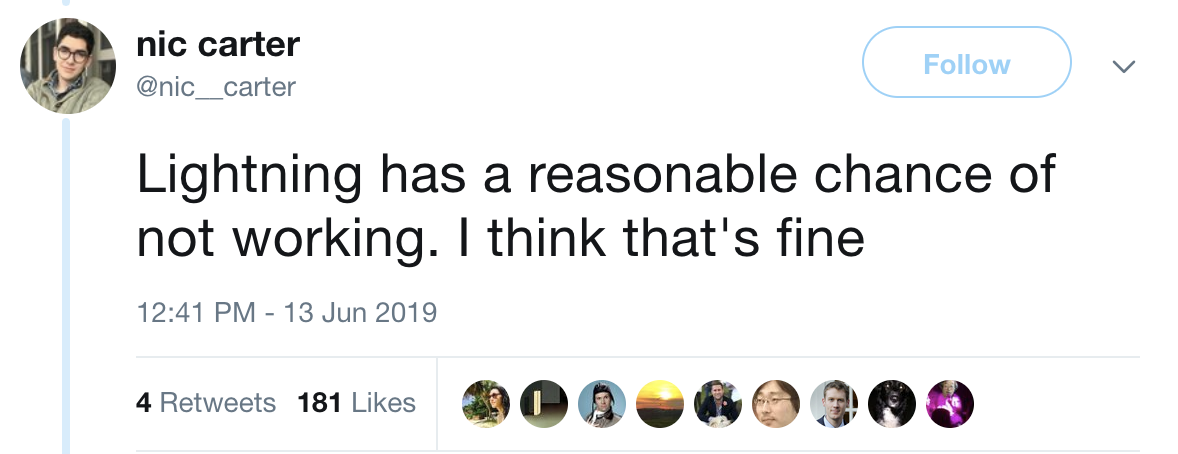Remember that layer two scaling solution they promised for Bitcoin back in the day? Does anyone know what happened to it? It feels like we’ve been waiting for a finished Lightning Network longer than Mt. Gox victims have been awaiting restitution. For now, Lightning is accessible to users with the skills to navigate its quirks and complexities, but for beginners, LN can be bewildering – and its challenges don’t end there.
Also read: Bitcoin Trades for a Premium in Hong Kong During Protests
Scaling Solution or Solution in Search of a Problem?
As the first major layer two project to be built on Bitcoin Core, Lightning is literally a lightning rod for critics of offchain scaling. Building a second layer solution as ambitious as LN was always going to be a huge undertaking, even with millions of dollars of investment and the support and goodwill of a vast swathe of the BTC community. Regardless of whether Lightning sinks, swims or treads water, its development will not have been entirely in vain.

At the time of publication, LN has a capacity of 949 BTC, down from its peak of over 1,000. The number of nodes and channels has also dropped in the last 24 hours, resulting in a current total of 8,780 nodes, around 60% of which have active channels. The average channel capacity stands at 0.027 BTC, while the average node capacity is 0.216. Lightning Network is presently capturing just 0.0045% of all available BTC. Critics have seized upon this as evidence that Bitcoin’s much-vaunted scaling and micropayment solution isn’t seeing use. Defenders have stressed that as an instant payment rail for small purchases, the amount of BTC locked up in the network is immaterial; provided there’s enough liquidity to easily send and receive sub-$100 payments, LN is fit for purpose.

Lightning Network: The Good, the Bad and the Ugly
One reason why the Lightning Network’s capacity has decreased, from its March high of over 1,000 BTC, is on account of a single provider, LNbig, closing a bunch of channels. This provider was granting the network at least 25% of its liquidity, and their channel closure and removal of BTC locked on the network did not go unnoticed. 16 of the 20 largest nodes on the network are operated by LNbig. Explaining their decision, LNbig observed:
When you open a lot of channels – everyone scolds you that you are capturing the network. When you close – there are also concerns. I would be very happy if other large players would now open channels and bring more liquidity to the network. But oddly enough this almost does not happen.
They added: “I would like to encourage everyone to run more nodes in the network and put their liquidity there … I will give up the place with great joy. I have a lot of open and not working channels in which liquidity is locked on my part. But for the future of the network, I do not close most of them.”

Operating nodes and funding channels is currently a labor of love for LN benefactors, but the network can’t rely on their benevolence in perpetuity. LNbig, for example, claims to earn around $20 per month in commissions for transactions they route at a rate of 2-300 tx per day. The cost of opening and closing channels, on the main BTC chain, however, has been estimated to cost them around $1,000 in fees to date.
Ultra-low fees are one of Lightning’s USPs, but if these fees are insufficient to cover the costs of liquidity providers, is it hard to see how LN is sustainable. Calculating the number of transactions per day that occur on LN is difficult due to its design, but LNbig has estimated this figure to stand at less than 2,000. This would suggest that LN is currently seeing just 5% of the usage of Bitcoin Cash for payments.
Coming Soon Since 2016
The Lightning Network was an ambitious project from the outset, which goes some way towards explaining it being constantly “18 months away” since its inception. Lightning’s complexity extends not only to under the hood, but to the front-end as well. At present, getting started with LN calls for a degree of technical know-how, particularly if you want to set up your own node and hold your funds non-custodially. Due to problems that have emerged during the network’s lengthy development process, Lightning Labs have had to develop new components, adding additional moving parts that must be mastered and maintained.
For example, watchtowers will be added to LN soon, tasked with keeping an eye out for fraudsters trying to double spend by broadcasting old transactions. While watchtowers are likely to enhance the network’s security, it adds another step to the setup process for businesses or individuals wanting to operate a routing node. Moreover, watchtowers will be data-hungry, meaning that they will likely be operated by a few major players. Creeping centralization is a recurring theme with the Lightning Network; there is nothing to suggest that influential actors will abuse their position of trust, but it’s hard to shake the sensation that the system is steadily moving away from Bitcoin’s permissionless design.
… so I just need to already have a channel open and funded before I can pay a watchtower that I need before I open a channel. Okey dokey.
— Gavin Andresen (@gavinandresen) June 14, 2019
A Semi-Permissionless Network
In theory you can send funds to anyone on LN, but in practice there may be few channels to isolated users on the network, forcing you to go through a routing provider. It’s easy to imagine a scenario in which a U.S. routing provider refuses to have dealings with a known Iranian address for legal reasons, or where a dissident’s address is left isolated from the hub of the network for political reasons. It is evident that many of the greatest challenges facing the Lightning Network are not technical in nature.
One recurring issue is the lack of incentives between participants. At present, LN’s earliest adopters are bootstrapping the network out of the good of their hearts and because they want to see the project succeed. There’s nothing wrong with this of course; Bitcoin was born the same way. But at some stage, there needs to be economic incentives for participants to secure the network. Not only do channel providers make a pittance – or potentially a loss, depending on onchain fees – for their services, but watchtower operators also lack an incentive. Lightning Labs’ solution to this is to add in yet another function to the network – the ability for people to send funds to watchtower operators. It all seems like a lot of hard work, some would argue, to solve a problem that could have been fixed overnight by increasing the block size.

But to make such assertions is to veer into deeply political territory. For ideological reasons, “big blockers” and their small block counterparts took opposing forks in the road to Bitcoin scaling long ago. Now that the Bitcoin Core camp is married to Lightning, there can be no going back. The economic and emotional ties run too deep. It’s unclear if or when LN will be considered production ready, but it remains a fascinating project that will likely exist in some shape or form, whatever happens. Even if it fails, Lightning will surely inspire the next wave of second layer solutions to be built on Bitcoin.
With Bitcoin Core supporters having spent the last two years arguing that BTC is a store of value and not a medium of exchange, their biggest challenge, in a post-Project Libra world, may be convincing the public to start spending bitcoin again.
What are your thoughts on Lightning Network? Let us know in the comments section below.
Images courtesy of Shutterstock.
Did you know you can verify any unconfirmed Bitcoin transaction with our Bitcoin Block Explorer tool? Simply complete a Bitcoin address search to view it on the blockchain. Plus, visit our Bitcoin Charts to see what’s happening in the industry.
The post What’s the Deal With the Lightning Network? appeared first on Bitcoin News.
Powered by WPeMatico
